J. Northw. Atl. Fish. Sci., Vol. 54: 1–16
Publication (Upload) date: 4 May 2023
N. Cadigan1 and M. Simpson2
1Centre for Fisheries Ecosystem Research, Fisheries and Marine Institute - Memorial University of Newfoundland, St. John’s, NL, Canada. A1C 5R3. noel.cadigan@mi.mun.ca
2Fisheries and Oceans Canada, Northwest Atlantic Fisheries Center, 80 East White Hills, St. John’s, NL, Canada. A1C 5X1. mark.simpson2@dfo-mpo.gc.ca
Cadigan, N., and Simpson, M. 2023. Contemporary analyses of comparative fishing data: a case study of Thorny skate on the Grand Banks (NAFO Divisions 3LNOP). J. Northw. Atl. Fish. Sci. 54: 1–16. https://doi.org/10.2960/J.v54.m739
Abstract
We re-analyze Thorny skate data from two comparative fishing experiments conducted by DFO in 1995 and 1996 using improved and more contemporary methods to estimate the relative efficiency of the Campelen 1800 demersal shrimp trawl survey protocol compared to the Engel 145 otter trawl. We correct possible bias in the method previously applied to these data. We investigate if there are size-based differences and if depth or spatial regions have important effects on results. We also investigate the influence and robustness of the estimation procedures, which was a concern in the original analyses of these data for other groundfish species. We did not find strong evidence that the relative efficiency of the Campelen trawl protocol compared to the Engel was different for smaller-sized Thorny skate compared to larger ones. However, we conclude that there is a potential that size-based differential catchability existed but there is insufficient information to reliably estimate these effects for Thorny skate. We also found evidence of significant differences in relative efficiency among NAFO Divisions and experiments, which is similar to other flatfish species. However, the mechanisms for these differences are unknown and it is not clear if spatial estimates should be used when converting Engel indices to Campelen equivalents. Hence, we do not recommend a different Engel-Campelen conversion factor than the one currently used in stock assessments for Thorny skates on the Grand Banks (NAFO Divisions 3LNOPs).
Keywords: Paired-tows; Binomial distribution; generalized linear mixed-effects model; influence; Robson estimator.
PDF
Download Citation Data

Citation to clipboard
 Reference management software (Endnote, Mendeley, RefWords, Zotero & most other reference management software)
Reference management software (Endnote, Mendeley, RefWords, Zotero & most other reference management software)
LaTex, BibDesk & other specific software
Introduction
Bottom-trawl surveys provide important inputs for the assessment of Grand Banks Thorny skate (Amblyraja radiataDonovan, 1808) in NAFO Divisions 3LNO and Subdivision 3Ps (Simpson and Miri, 2020). The main source of information comes from Fisheries and Oceans (DFO) research vessel (RV) surveys in the spring that cover the entire stock area. DFO RV surveys in autumn in Divisions 3LNO are also examined but these surveys do not cover the stock component in 3Ps. Stock status is based on spring survey indicators since 1971; however, different vessels and survey gears have been used throughout this time-period, and some of these changes had substantial impacts on survey catch rates. Survey indices during 1984–1995 when the Engel trawl was employed were adjusted to be comparable with recent survey protocols that used the Campelen trawl; however, there is substantial uncertainty about values for the adjustments, which is the focus of this paper.
During 1971–1982 the DFO spring surveys were conducted using the research vessel A.T. Cameron which fished with a Yankee 41.5 otter trawl. Starting in 1983, surveys were conducted using the stern trawler Wilfred Templeman with the Engel 145 High Lift otter trawl. Although comparative fishing (see below) between the two vessels and gears was conducted (Gavaris and Brodie, 1984), no length data were collected for Thorny skate. Hence, survey catch rates from these vessels used during different periods may not be directly comparable to indicate stock trends.
Major changes in both the spring and fall surveys occurred in the mid-1990s. In 1995, DFO changed survey vessels, bottom trawls, and tow durations in their fall RV surveys on the NL shelves. The vessel CCGSTeleostreplaced the MV Gadus Atlantica, and the Engel 145 High Lift otter trawl was replaced by the Campelen 1800 shrimp trawl. The Campelen trawl was known to be much more efficient at catching small fish (Walsh, 1996). The Engel survey trawl was also changed to the Campelen trawl on another research vessel, the CCGS Wilfred Templeman, which was used for both spring and fall surveys. In both cases, tow times were reduced from 30 minutes to 15 minutes. Other changes in survey protocols were summarized in Warren (1996; 1997), McCallum and Walsh (1997), and more recently by Cadiganet al. (2022). Well-designed scientific surveys can produce annual indices, Iy, t size, Ny(i.e., Iy ≈ QNy. If catchability (Q) is the same each year then trends in indices reflect trends in stock size. However, a large change in survey protocols can affect Q and that disrupts the survey index time-series as an indicator of stock size.
Comparative fishing experiments can provide information about the relative change in Q for the old survey protocol compared to the new one, ρ = Qold /Qnew, which we refer to as the relative efficiency of the old protocol. This can be used to adjust for changes in survey index catchability. Comparative fishing experiments usually involve paired-trawling by two vessels that use the old and new survey protocols. Comparative or calibration fishing is the international standard in developed countries for calibrating catches and integrating pre-existing/current time-series with new time series (Bagley et al., 2015; Thiess et al., 2018). However, it is often difficult to conduct comparative fishing (e.g. when only a trawl gear is changed in a single vessel survey) or it may be prohibitively costly, especially in cases where multiple vessels are used each year to conduct surveys (e.g., ICES, 2006; Bagley et al., 2015; ICES, 2022). In these cases, survey index standardization is aided by using a phased-in approach for changes in survey protocols, where some vessels use the old protocols and some use the new protocols, during the same survey and so that both protocols are used in some nearby locations. Index standardization can be performed using statistical models (e.g. Berg et al., 2014; Thorson and Ward, 2014; O’Leary et al., 2021) that include vessel and/or gear effects. However, such model-based approaches may not be reliable if there is insufficient overlap in the vessels and gears used (e.g. Winker et al., 2017). Dedicated comparative fishing ensures this overlap.
In 1995 and 1996, DFO conducted comparative fishing experiments to 1) investigate the relative efficiency of the Gadus Atlantica with the Engel trawl versus the Teleost with the Campelen, and 2) the Alfred Needler with the Engel trawl and the Wilfred Templeman and the Campelen trawl. The Alfred Needler and the Wilfred Templeman were sister ships, and it was expected that their differences in catchabilities would provide a good approximation of the differences in catchabilities of the Wilfred Templeman using the Engel trawl versus the Campelen trawl. In effect, the assumption was that the Alfred Needler and the Wilfred Templeman would have the same catchability when each vessel used the same Campelen survey gear; that is, there was no vessel effect. This assumption was later validated in subsequent comparative fishing experiments between these two vessels, both fishing with the Campelen trawl (Cadigan et al., 2006). Additional information on the comparative fishing results is provided in Warren (1996) and Warren et al. (1997).
Simpson and Kulka (2005) initially analyzed the comparative fishing results for Thorny skate to estimate the relative efficiency of the Campelen surveys compared to the Engel surveys. Their purpose was to convert Gadus Atlantica catches with the Engel trawl to values equivalent to what would have been obtained by the Teleost and the Campelen. Similarly, Wilfred Templeman catches using the Engel trawl were converted to Campelen equivalents. Simpson and Kulka (2005) did not find evidence of size-based differential catchability of the Campelen and Engel trawls for Thorny skate. However, the relative efficiency of the Campelen trawl survey protocol compared to the Engel was strongly length-dependent for the target groundfish stocks in these comparative fishing experiments (Warren, 1996; Warren et al., 1997; Cadigan et al., 2022). Hence, it is reasonable to expect that Thorny skate relative efficiency may also be length dependent, but there was insufficient length measurements to detect the effect.
There have been few other comparative fishing studies for thorny skate using the Campelen trawl. To our knowledge the most relevant one was conducted in the northern Gulf of St. Lawrence in 2004 and 2005. This involved paired-tow comparative fishing between the Alfred Needler with a with a URI 81'/114' shrimp trawl compared to the Teleost with the Campelen shrimp trawl (Bourdages et al., 2007). They found that, when standardized for the same area swept, the Campelen trawl was about eight times more efficient than the URI for catching large thorny skate (~ 60 cm) but only 2.5–3.1 times more efficient for thorny skate between 10–20 cm. However, their results (Fig. 5 in Bourdages et al., 2007) did not provide strong evidence of a change in relative efficiency for sizes greater than 20 cm, as evidence by the flat exponential curve at these sizes. We caution that the results in Bourdages et al. (2007) may have little relevance to the relative efficiency of the Campelen trawl compared to the Engel trawl because the URI shrimp trawl used in northern Gulf of St. Lawrence research surveys was substantially different than the Engel groundfish trawl used in the surveys we investigate.
The methods used to estimate conversion factors for a change in survey protocols have improved since Simpson and Kulka (2005). It is now common to analyze comparative fishing using Binomial or Beta-binomial logistic regression and to account for between-tow variability in relative efficiency using mixed-effect models (e.g. Benoît and Swain, 2003; Benoît, 2006; Fowler and Showell, 2009; Cadigan and Dowden, 2010; Cadigan and Power, 2011; Miller, 2013; Fabrizio et al., 2017; Jones et al., 2021; Cadigan et al., 2022; Delargy et al., 2022). In this paper we re-analyze the DFO 1995 and 1996 Engel-Campelen comparative fishing data for Thorny skate using these methods to estimate the relative efficiency of the Campelen trawl survey protocol compared to the Engel protocol. We correct possible bias caused by the methods used by Simpson and Kulka (2005). We also investigate for size-based differences in relative efficiency, which there is strong evidence for other species (e.g. Cadigan et al., 2022). This latter issue is difficult for Thorny skate because sizes were measured infrequently, which we describe below. Also, the comparative fishing tows were not randomly distributed throughout the stock area. If there are significant covariate effects (i.e., depth, location) for relative efficiency, then this may also be a source of bias if the distribution of these covariates in the comparative fishing experiments is different than the distribution of the covariates that is typical in a survey. Hence, we also investigate if there were significant effects for depth or spatial region. We also investigate the robustness of the estimation procedures, which was a concern in the original analyses of these data for other groundfish species (Warren, 1996; Warren et al., 1997).
Materials and Methods
We first describe the data collected for Thorny skate in the DFO 1995 and 1996 Engel-Campelen comparative fishing experiments. This is then followed by a description of the model we use to estimate relative efficiency, which is naturally influenced by the data available.
Data
The Gadus Atlantica-Teleost and Alfred Needler-Wilfred Templeman comparative fishing experiments were conducted in NAFO Divisions 3LNOP (Fig. 1) with some sets also in Subdivision 4Vn (west of 3Ps). Sets locations were targeted in areas and depths where target species were thought to occur (Warren, 1996; Warren et al., 1997). Although Thorny skate was not a target species, the catches of this species were recorded and some length information was collected (see below). The locations fished in the comparative fishing experiments are also somewhat different than the recent typical distribution of Thorny skate (e.g. see Figs. 11a,b in Sosebee et al., 2022). The Alfred Needler-Wilfred Templeman CF sets in 3Ps were located along the northeast slope of Laurentian Channel (western part of Div. 3Ps, Fig. 1) and did not cover much of the Burgeo, Hermitage, and Halibut channels (in Div. 3Ps, see https://www.dfo-mpo.gc.ca/oceans/publications/nfld-atlas-tnl/page02-eng.html#grandbanks) where there have been relatively high catches of Thorny skate in recent years. Similarly, there were no CF sets in the southeast part of 3N where thorny skate are also found. There was only one Alfred Needler-Wilfred Templeman CF set in 3L, although this Division has lower thorny skate abundance compared to 3NOPs. This has potential implications on how these data should be used, which is described below. Both experiments involved three trips to different areas (Fig. 2).
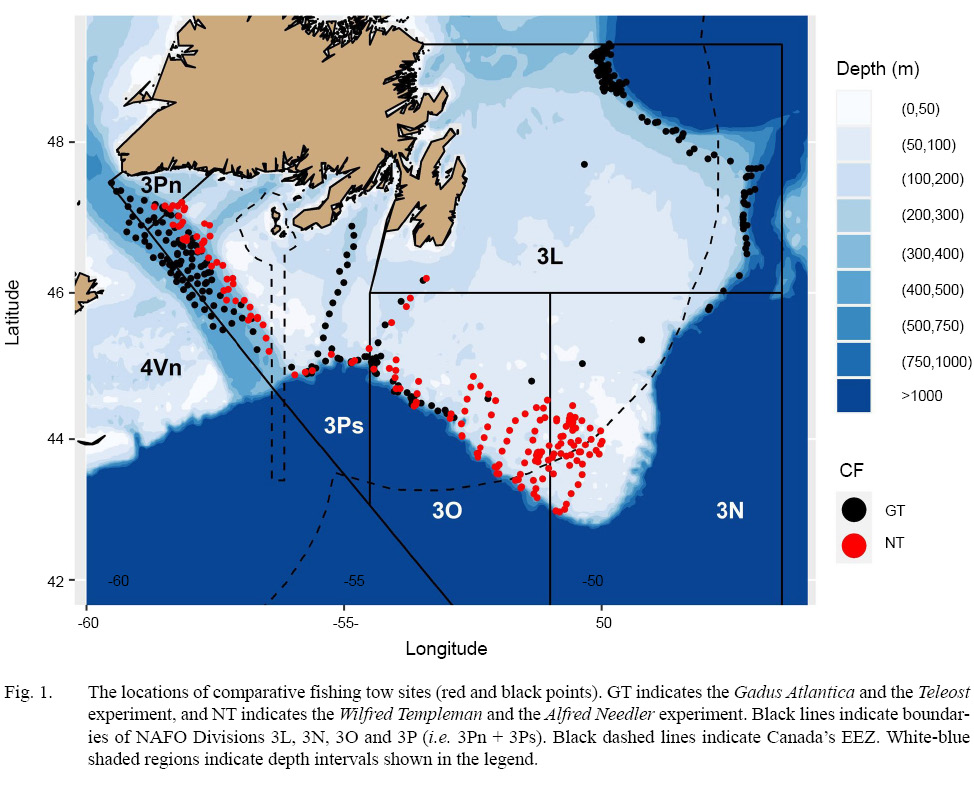
Fig. 1
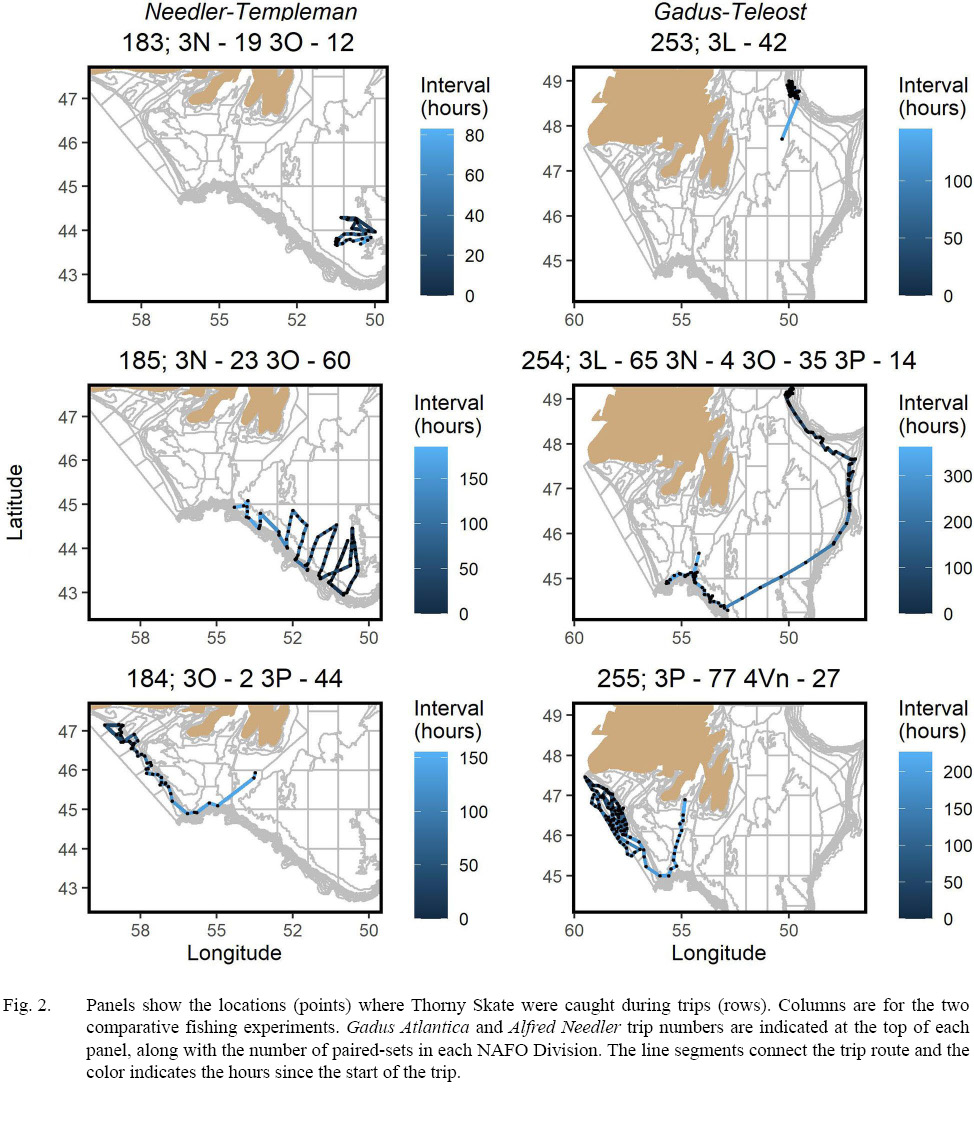
Fig. 2
The methods used by Warren (1996), Warren et al. (1997) and Cadigan et al. (2022) to estimate length-based relative efficiency required lengths to be measured by both vessels in each paired-tow, and these methods are not applicable to Thorny skate because lengths were usually not measured by each vessel for the same paired-tows (see Results). Lengths were only measured for 10 Wilfred Templeman sets and 15 Gadus Atlantica sets, but for the latter there were no length measurements by the Teleost and for the same paired-tows. A coarse way to assess if there were size effects in relative efficiency is to stratify total catches (from both trawls and for all sizes) by average body weight. Basically, this involves estimating relative efficiency in sets with catches of mostly smaller fish compared to sets with mostly larger fish. Because of the much smaller Campelen trawl mesh size compared to the Engel, we expect to see relatively more catch from the Campelen trawl in tow-pairs that caught smaller fish in total (i.e. both trawls) than in tow-pairs that caught larger fish. Defining large and small sizes is subjective, and to achieve reasonable sample sizes of small and large sizes of fish we divided the catches based on the weight of a 45 cm fish (0.93 kg), which was closer to the median weight of 1.02 kg for the Gadus Atlantica-Teleost experiment and 1.65 kg for the Alfred Needler-Wilfred Templeman experiment.
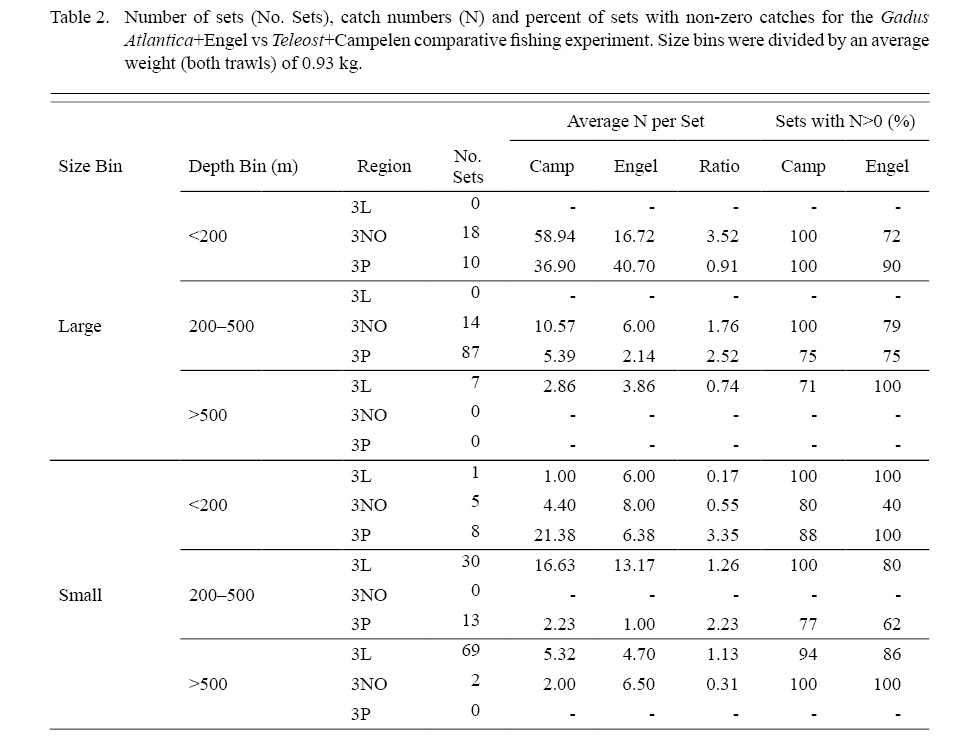
Table 2
Catchability and relative efficiency may also vary spatially because of habitat differences (e.g. slope, sediment type) that may affect escapement through the footgear (Kotwicki et al., 2013; Thorson et al., 2013), among other reasons. Cadigan et al. (2022) found that spatial region effects (i.e., NAFO Divisions) were important for the flatfish species they studied. Relative efficiency may also vary with depth because of depth-dependent differences in trawl geometry (e.g., Weinberg and Kotwicki, 2008; Dean et al., 2021) and fish behavior (Winger, Eayrs, and Glass, 2010). This is important because the set locations in the comparative fishing experiments were not distributed randomly throughout 3LNOP and therefore the average relative efficiency at the locations sampled in these experiments may not apply to the whole survey area if relative efficiency varies with space and depth. Data were too limited to attempt to estimate spatial or depth effects at a fine scale. However, we investigate this using coarse post-stratification of the catches. For spatial effects we used NAFO Divisions, but we combined 3N and 3O because of the low number of sets in the Gadus Atlantica-Teleost experiment in this area, and the sets in the Alfred Needler-Wilfred Templeman experiment occurred mainly in a relatively small region in Divisions 3N and 3O (see Fig. 1). We also post-stratified by depth: < 200 m, 200–500 m, and > 500 m. These three depths bins were selected so that there was a balance of tows in each depth bin for the two experiments. The number of comparative fishing sets for each size, depth, and region bin are shown in Table 2 and Table 3. There was only one tow-pair in 3L which did not catch any Thorny skate in the Alfred Needler-Wilfred Templeman experiment, and these vessels also did not fish greater than 500 m.
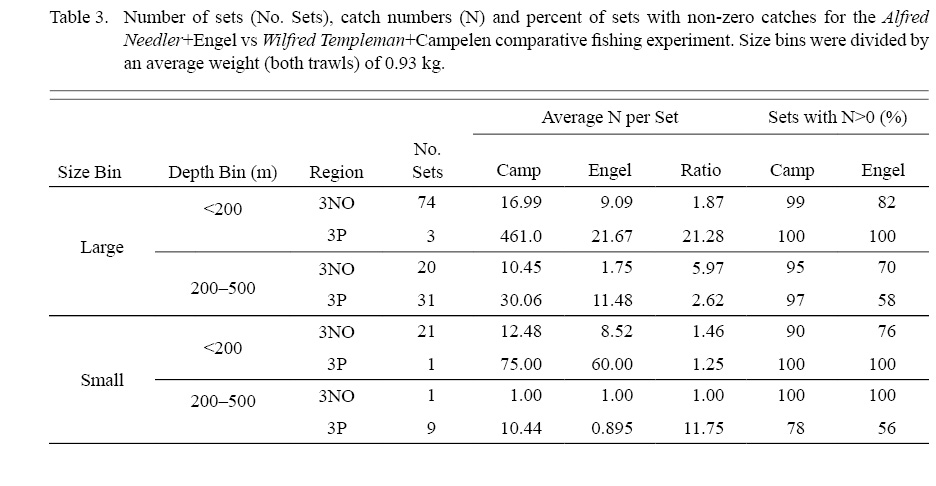
Table 3
Model and Estimation
The basic data obtained from the paired-tow calibration studies are the catch numbers Yij at the ith paired-tow station (i=1, . . . ) by the old and new survey protocols at sites j=1 (old) or j=2 (new). Site refers to the different locations fished at a trawl station. Let λij denote the fish densities encountered at station i and site j. The distribution of Yi1 (i.e. catch-at-length from the old protocol) conditional on the total catch-at-length by both vessels (Ni=Yi1+Yi2) was assumed to be Binomial (e.g., Cadigan and Dowden, 2010; Cadigan et al., 2022) with probability pi that a caught fish came from the old survey protocol. If logρ1=τ then the Binomial probability is defined via the logistic equation,
 (1)
(1)
where δi=log(λi1/λi2). If survey catches are subsampled or there are within-survey variations in tow distances and swept-areas then this should be accounted for (e.g., Cadigan et al., 1996; Miller, 2013) in Eqn. (1); however, we ignore these issues for simplicity because they were not problems for the Thorny skate CF data. We assumed δi varied randomly and independently from station to station (i.e. i). Note that if λi2=λi1 then δi=0. Like Cadigan and Dowden (2010), we assumed that the δi’s were independent Normal random variables with mean zero and variance σδ2. We estimated the model using the glmer() function with the lme4 R package (Bates et al., 2015). We also fit linear models with τ being a function of size, depth, and regions effects.
We examined model goodness of fit using Gaussian quantile residuals and the R package DHARMa (Hartig, 2022). Fig. 3 and Fig. 4 indicate that there were a few tow-pairs with relatively large catches that could potentially have large influence on the estimates of τ. We used the R package influence.ME (Nieuwenhuis et al., 2012) to compute Cook’s distance Ci for each tow-pair (i), which is a measure of the size of , where is the estimate of τ using all tow-pairs and τ^-i is the estimate with the i’th tow-pair removed. A relatively large value for Ci indicates that tow-pair has a relatively large effect on the estimate of τ.
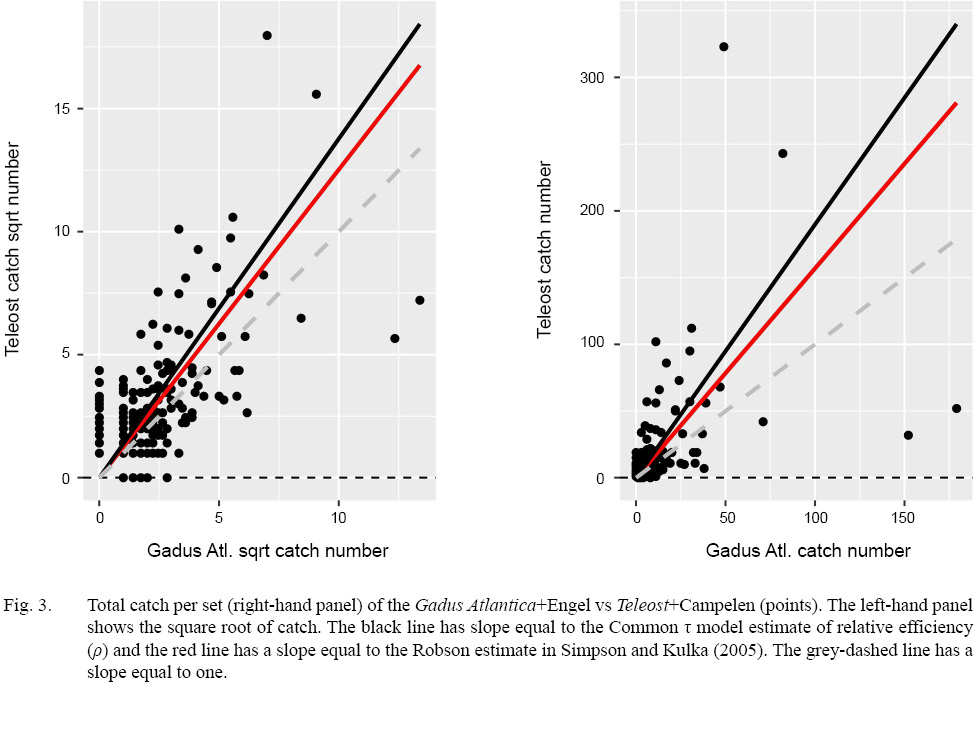
Fig. 3
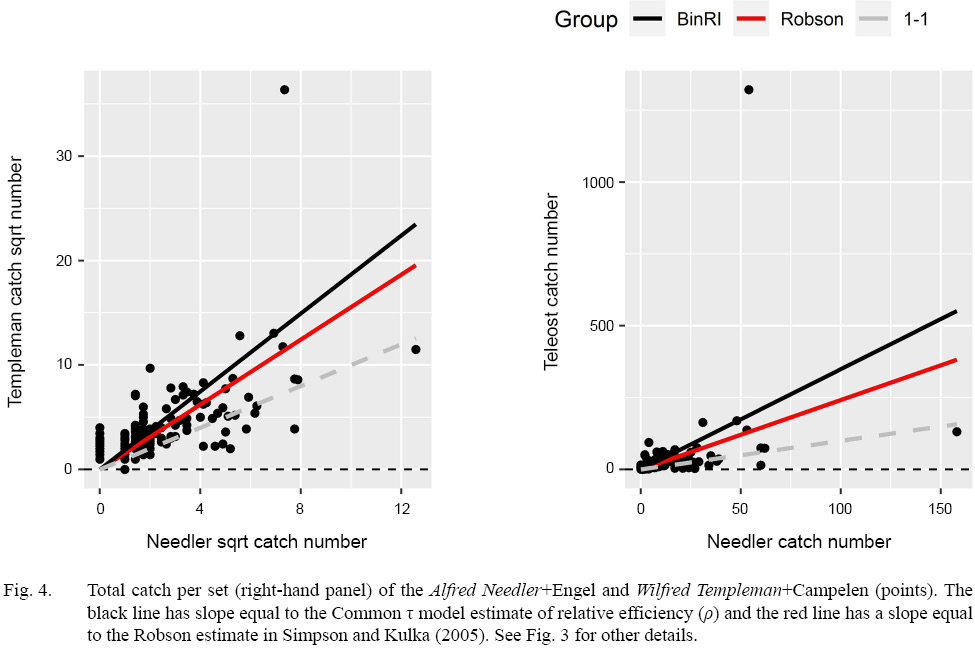
Fig. 4
Results
Data
The total catch-per-tow of Thorny skate (one trawl versus the other) for all comparative fishing tows are shown in Fig. 3 for the Gadus Atlantica-Teleost experiment and Fig. 4 for the Alfred Needler-Wilfred Templeman experiment. These data are also summarized in Table 1.
Length data collected in the comparative fishing experiments are summarized in Fig. 5. These data are inconsistent with the length-aggregated results. For example, the proportion of total catch-at-length from the Engel trawl in the Alfred Needler-Wilfred Templeman experiment was usually around 0.9 whereas Table 1 indicated that the Campelen trawl caught about three times more Thorny skate than the Engel trawl. Thorny skate were usually measured for length in only one trawl for each tow-pair (bottom panel of Fig. 5) and this may be the reason for the difference in the length-specific and total catch results. The distribution of total catch-at-length for the Alfred Needler-Wilfred Templeman experiment in Fig. 5 is very similar to Simpson and Kulka (2005; Fig. 3a). Hence, it seems that Thorny skate were not measured for length consistently for each tow-pair and the length data are not reliable for estimating length-effects in ρ. Samples sizes were too low to compare average catch-at-length across tows; for example, those averages were strongly influenced by two tows with relatively large catches by both vessels in the Gadus Atlantica-Teleost experiment.
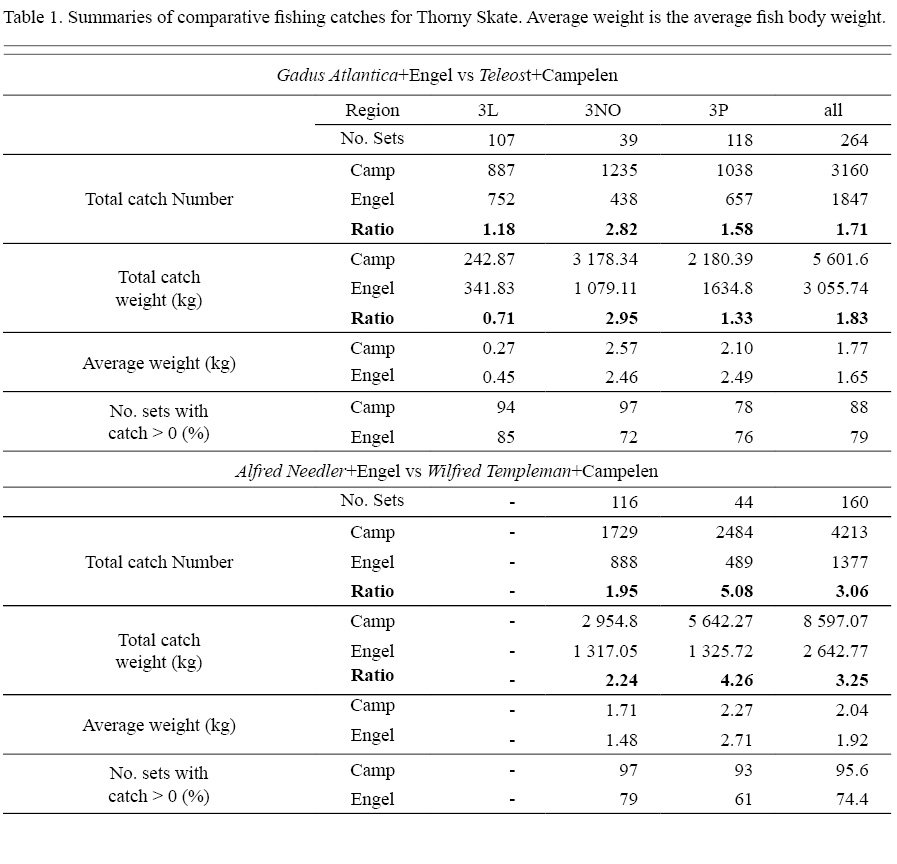
Table 1
Model
We investigated potential covariate effects by fitting a model with main effects for size class, depth, and region, and interaction between depth and region (Table 4). The data are insufficient to estimate interactions with size, and we can only assume that size effects are approximately the same at different depths and spatial regions. This model indicated that the relative efficiency of the Campelen trawl was significantly lower for smaller sizes than larger sizes compared to the Engel trawl for the Alfred Needler-Wilfred Templeman experiment (small size effect = -0.52). The total catch by the Wilfred Templeman+Campelen was 3.3 times larger than the Alfred Needler+Engel for tows with larger Thorny skate (Table 3), but only 1.7 times larger for tows with smaller fish. This is opposite to our expectations based on the much smaller mesh size of the Campelen trawl; however, this result may be strongly influenced by the very large catch in one tow by the Wilfred Templeman+Campelen (Fig. 4). The size effect was not statistically significant for the Gadus Atlantica-Teleost experiment. Some of the region and depth interaction terms were significant; however, some parameter correlations were large so we decided to fit models without interaction terms (Table 5). Size effects for both experiments still indicated lower relative efficiency for the Campelen trawl for small sized fish, whereas we expected the size effect to be substantially positive. Some parameter correlations were still large for these models, especially for the Gadus Atlantica-Teleost experiment. Hence, we also investigated models with only spatial region effects (Table 6), and no covariate effects at all, similar to Cadigan et al. (2022). These simple models indicated that relative efficiency was significantly lower in 3L compared to 3NO and 3P with the Gadus Atlantica-Teleost experiment, but there was no significant difference between 3NO and 3P. Also, relative efficiency was significantly higher in 3P compared to 3NO with the Alfred Needler-Wilfred Templeman experiment. The estimate of ρ for 3P was about 2.4 times the estimate for 3NO.

Fig. 5
Model selection results (Table 7) indicated that the models with spatial region effects were the most parsimonious. This model had the lowest BIC statistic for both experiments, and reasonably low AIC values. However, the model with main effects was also a good choice for the Alfred Needler-Wilfred Templeman experiment.
The estimates of ρ from the “Common τ’’ model (ρ equal for all trips, see Table 6) were significantly greater than one and greater than the Robson estimates in Simpson and Kulka (2005). The estimate for the Gadus Atlantica-Teleost experiment was ρ^=1.90 compared to the Robson estimate of 1.57 (Fig. 3). The estimate for the Alfred Needler-Wilfred Templeman experiment was ρ^=3.48 compared to the Robson estimate of 2.42 (Fig. 4). The “Common τ’’ model 95% confidence intervals did not contain the Robson estimates for either experiment.
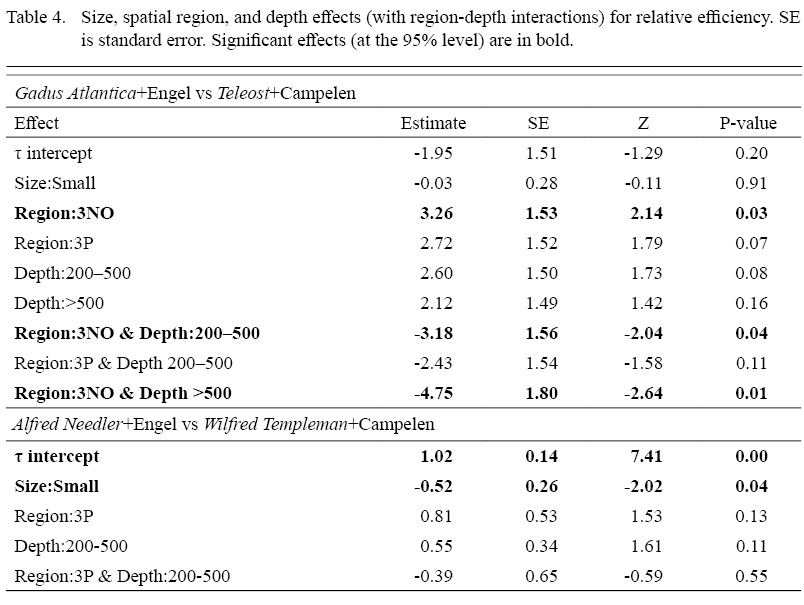
Table 4

Table 5
There was no evidence of lack-of-fit in residual diagnostics for both experiments; the “Common τ’’ model p-values for KS test of normality were 0.95 and 0.86 for the Gadus Atlantica-Teleost and Alfred Needler-Wilfred Templeman experiments, respectively.
Robustness and sensitivity of estimates to a small number of tows is a concern. There were some tows with Cook’s distance values (Fig. 6 and Fig. 7) greater than the rule-of-thumb threshold indicated in Nieuwenhuis et al. (2012). To further investigate this issue, we deleted the data for the tow in 3P of the Alfred Needler-Wilfred Templeman experiment (Fig. 7) with the largest Cook’s distance. However, this had only minor impacts on results. The estimate of ρ decreased from 3.49 to 3.39. The Model 2 (see Table 6) estimate of ρ for 3P decreased from 6.58 to 6.17 and estimates for 3NO hardly changed at all. Also, Model 2 still fit significantly better (Chi-square p-value = 0.0007). This suggests that our results are not sensitive to a small number of anomalous tow-pairs.

Table 6
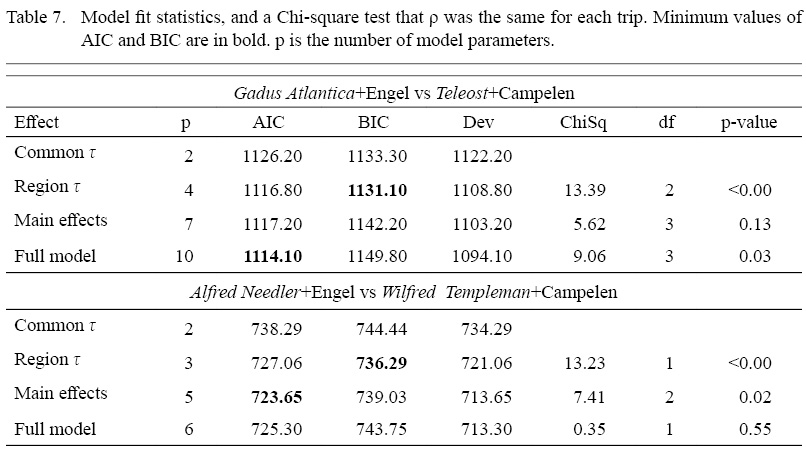
Table 7
Discussion
We re-analyzed comparative fishing data collected by DFO in 1995 and 1996 dealing with changes in surveys vessels, gears, and other protocols that occurred then. The data collected for Thorny skate were originally analyzed by Simpson and Kulka (2005); however, the Robson conversion factors they estimated were based on a linear model of log-transformed catches and this estimator could only be applied to paired-tows in which both vessels caught Thorny skate. When one vessel had a different proportion of sets with no catch, which is the case for Thorny skate in the 1995 and 1996 DFO comparative fishing experiments (see Table 1), then this will be a source of bias. We think this is the reason why the Robson estimates in Simpson and Kulka (2005) were significantly lower than our estimates (i.e., less than our lower confidence interval limits). The estimation procedures we used are consistent with current practice (Cadigan and Dowden, 2010; Miller, 2013; Cadigan et al., 2022) based on the distribution of the catch from one vessel/gear, conditional on the total catch from both vessels/gears, with random effects to accommodate between-tow variation in relative efficiency or variations in the fish densities encountered by each vessel at a paired-tow site. These two sources of variation are confounded. We also demonstrated that our estimates of relative efficiency were robust to anomalous catches which was a concern with these data (Warren, 1996; Warren et al., 1997). Hence, we conclude that our estimation methodology is an improvement over Simpson and Kulka (2005). Nonetheless, our estimates of relative efficiency of the Campelen trawl survey protocol compared to the Engel were similar to Simpson and Kulka (2005) in that both approaches estimated much greater catchability by the Campelen trawl, although our approach estimated a substantially higher increase in catchability compared to Simpson and Kulka (2005). Based on a model with a single relative efficiency parameter (ρ), we estimated ρ = 1.90 for the Gadus Atlantica+Engel vs Teleost+Campelen experiment, which was 21% higher than the value ρ = 1.57 in Simpson and Kulka (2005). Similarly, we estimated ρ = 3.49 for the Alfred Needler+Engel vs Wilfred Templeman+Campelen experiment, which was 44% higher than the value ρ = 2.42 in Simpson and Kulka (2005).
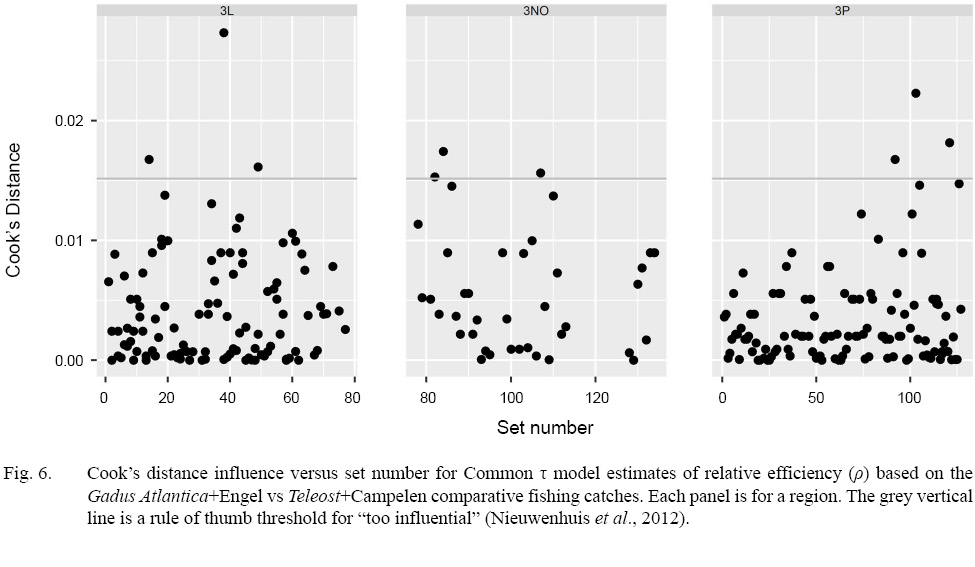
Fig. 6
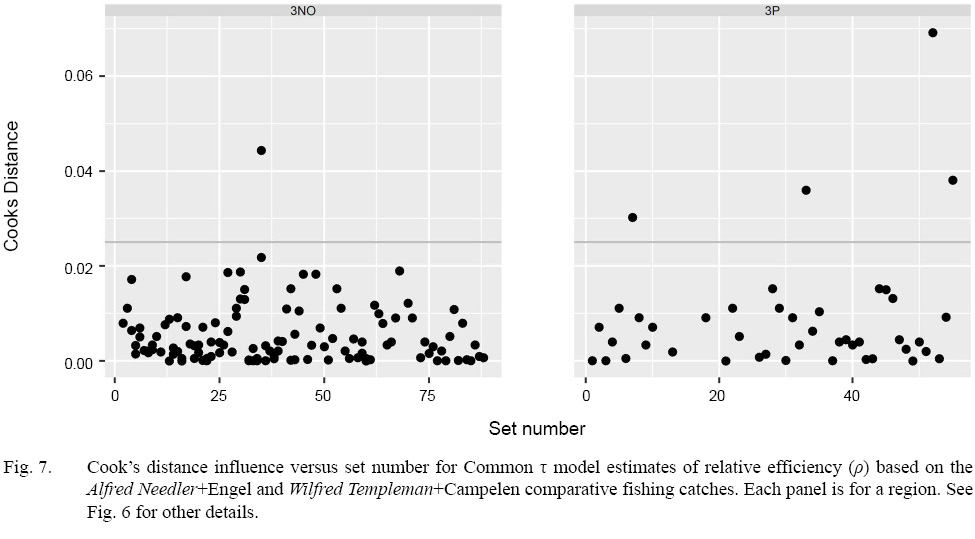
Fig. 7
We also investigated if there were differences in relative efficiency among NAFO Divisions, depth categories, or size categories. This is important because tow-pairs were not randomly allocated in the 1995 and 1996 comparative experiments and conversions factors may not be generally applicable to surveys if there were spatial/depth variation in relative efficiency or differences among sizes of Thorny skates. The data available did not support detailed modelling of these effects, especially for length-effects. Our results indicated that the relative efficiency of the Campelen trawl protocol compared to the Engel for smaller-sized Thorny skate was lower than for larger-sized fish. We found this result for both comparative fishing experiments, although the difference in relative efficiency for small and large sizes was only significant for the Alfred Needler+Engel vs Wilfred Templeman+Campelen experiment. This result was opposite to our expectation that relative efficiency for smaller sizes should be greater than for larger sizes because of the smaller mesh size in the Campelen trawl. Our size-based results were based on a post-stratification of surveys catches by average body weights caught by both vessel/gears, which we admit is a crude approach. Unfortunately, length information was not consistently collected for Thorny skate by both vessels at each paired-tow site so we were unable to implement more detailed estimators like Cadigan and Dowden (2010), Miller (2013), and Cadigan et al. (2022). However, overall, our model selection results indicated the most parsimonious model did not include size effects which is consistent with Simpson and Kulka (2005) who concluded that there was no evidence of size-based differential catchability of the Campelen and Engel trawls for Thorny skate. However, we conclude that there is a potential that size-based differential catchability existed but we have insufficient information from the 1995 and 1996 comparative fishing experiments to reliably estimate these effects.
Our best-fitting models included spatial regions effects (i.e., NAFO Divisions). We found that relative efficiency was significantly lower in 3L compared to 3NO and 3P with the Gadus Atlantica-Teleost experiment, but there was no significant difference between 3NO and 3P. Also, relative efficiency was significantly higher in 3P compared to 3NO with the Alfred Needler-Wilfred Templeman experiment. The estimate of ρ for 3P was 2.4 times greater than the estimate for 3NO. The latter result is consistent with Cadigan et al. (2022) who estimated lower relative efficiency of the Alfred Needler-Engel trawl survey protocols compared to the Wilfred Templeman-Campelen in 3P for larger sizes of yellowtail flounder (Limanda ferruginea), witch flounder (Glypocephalus cynoglossus), and American plaice (Hippoglossoides plattesoides) but little difference for Greenland halibut (Reinhardtius hippoglossoides). We do not know why the Campelen relative efficiency was higher in this experiment and region compared to other regions. Also, the estimates of Campelen relative efficiency for larger-sized flatfish in Cadigan et al. (2022), which were broadly consistent with original estimates in Warren (1996) and Warren et al. (1997), were in the range of 0.8–1.7 at 40 cm, which is much lower than the value we estimated for Thorny skate (i.e. ρ = 3.49).
Since the swept area of the Engel trawl was almost 3-times as large as the Campelen (McCallum and Walsh, 1997; Cadigan et al., 2022), our results, and Simpson and Kulka (2005), indicate that the catch numbers per unit area of the Campelen trawl for Thorny skate was about nine times greater than the Engel trawl. A partial explanation is high escapement of Thorny skate through the larger bobbin footgear used with the Engel trawl compared to the smaller rockhopper footgear of the Campelen trawl, which results in more seabed contact. Walsh (1992) found that 69% of Thorny skate encountered by the Engel trawl escaped through the footgear, but the mean size of fish that escaped was only slightly less than those retained in the trawl. Similar experiments were not conducted with the Campelen trawl (e.g. Kulka and Miri, 2007). Hence, about 30% of the Thorny skate encountered by the Engel trawl were captured according to the results in Walsh (1992). However, if we assume that 1) there was no escapement through the Campelen rockhopper footgear, 2) Thorny skate that entered the Engel and Campelen trawls were retained equally, and 3) if the Engel trawl survey protocol encountered about three times more Thorny skate than the Campelen protocol because of the 3-times larger swept-area, then we would expect the relative efficiency of the Campelen and Engel survey protocols to be about one. Our CF estimates are much greater than one. Hence, we conclude that other factors affected catches of Thorny skates by the two survey protocols than only swept area and escapement through the footgear, or that escapement through the Engel rockhopper gear was much greater than indicated by Walsh (1992). Evidence of higher escapement for cod and yellowtail flounder was provided by Walsh (1996). It is possible that increased retention of small fish by the Campelen trawl could account for its much higher catch numbers per unit area compared to the Engel trawl. In this case a common conversion factor for all sizes, as is currently applied in assessments of this stock, would not be appropriate. The appropriate conversion factor for large and mature sizes of Thorny skate may be lower than the one that has been used to convert Engel catches to Campelen equivalents.
The Alfred Needler-Engel versus Wilfred Templeman-Campelen comparative fishing sets in Division 3P occurred mostly along the southwest slope of the Laurentian Channel. The Campelen survey protocol seemed to be more efficient than the Engel there compared to 3NO, for Thorny skate and some flatfish species. We are unsure why this was. However, if we did not use the 3P results and only used comparative fishing sets in 3NO then the estimate of relative efficiency we obtained (ρ = 2.74) was more similar to the value ρ = 2.42 in Simpson and Kulka (2005), and their value is well within our 95% confidence interval for ρ in 3NO. Hence, we do not recommend a different Engel-Campelen conversion factor than the one currently used in stock assessments for Thorny skates in NAFO Divisions 3LNOPs (e.g. Simpson and Miri, 2020).
Acknowledgements
NC is funded by the Sustainable Fisheries Science Fund from Fisheries and Oceans Canada, an Ocean Choice International Industrial Research Chair Grant, and research funding provided by the Ocean Frontier Institute through an award from the Canada First Research Excellence Fund.
References
Bagley, N. W., Horn, P. L., Hurst, R. J., Jones, E., Parker, S. J. and Starr, P. J. 2015. A review of current international approaches to standardisation and calibration in trawl survey time series. New Zealand Fisheries Assessment Report, 46.
Bates, D., Maechler, M., Bolker, B., and Walker, S. 2015. Fitting Linear Mixed-Effects Models Using lme4. Journal of Statistical Software, 67: 1–48. https://doi.org/10.18637/jss.v067.i01
Benoît, H. P. 2006. Standardizing the southern Gulf of St. Lawrence bottom-trawl survey time series: results of the 2004–2005 comparative fishing experiments and other recommendations for the analysis of the survey data. DFO Can. Sci. Advis. Sec. Res. Doc. 2006/008. iii + 127 p.
Benoît, H. P., and Swain, D. P. 2003. Standardizing the southern Gulf of St. Lawrence bottom-trawl survey time series: adjusting for changes in research vessel, gear and survey protocol. Can. Tech. Rep. Fish. Aquat. Sci. no. 2505: iv + 95 pp.
Berg, C. W., Nielsen, A., and Kristensen, K. 2014. Evaluation of alternative age-based methods for estimating relative abundance from survey data in relation to assessment models. Fisheries Research, 151: 91–99. https://doi.org/10.1016/j.fishres.2013.10.005
Bourdages, H., Savard, L. Archambault, D., and Valois, S. 2007. Results from the August 2004 and 2005 comparative fishing experiments in the northern Gulf of St. Lawrence between the CCGS Alfred Needler and the CCGS Teleost. Can. Tech. Rep. Fish. Aquat. Sci. 2750: ix + 57 p.
Cadigan, N. G., Walsh, S. J., and Brodie, W. B. 2006. Relative efficiency of the Wilfred Templeman and Alfred Needler research vessels using a Campelen 1800 Shrimp Trawl in NAFO Subdivision 3Ps and Divisions 3LN. DFO Can. Sci. Advis. Sec. Res. Doc. 2006/085. iii + 59 p.
Cadigan, N. G., Boulos, D. L. and Hickey, W. M. 1996. Analysis of subsampled catches from trouser trawl size selectivity studies. Journal of Northwest Atlantic Fishery Science, 19: 41–49. https://doi.org/10.2960/J.v19.a4
Cadigan, N. G., and Dowden, J. J. 2010. Statistical inference about relative efficiency from paired-tow survey calibration data. Fisheries Bulletin, 108: 15–29.
Cadigan, N. G. and Power, D. 2011. Vessel calibration results for redfish (Sebastes sp.) from comparative fishing between the CCGS Teleost research vessel and the MV Cape Beaver fishing vessel. DFO Can. Sci. Advis. Sec. Res. Doc. 2010/062. iv + 17 p.
Cadigan, N. G., Walsh, S. J., Benoît, H., Regular, P., and Wheeland, L. 2023. A hierarchical model of the relative efficiency of two trawl survey protocols, with application to flatfish off the coast of Newfoundland. ICES Journal of Marine Science, fsad039. https://doi.org/10.1093/icesjms/fsad039
Dean, M. J., Hoffman, W. S., Buchan, N. C., Cadrin, S. X., and Grabowski, J. H. 2021. The influence of trawl efficiency assumptions on survey-based population metrics. ICES Journal of Marine Science, 78: 2858–2874. https://doi.org/10.1093/icesjms/fsab164
Delargy, A. J., Hold, N., Heney, C., Cann, R. P., Bhandari, K., Colvin, C. N., Moore, A. B., Lincoln, H., McCarthy, I. D. and Hiddink, J. G., 2022. Detection and quantification of differences in catch rates among research vessel gears and commercial vessels. Fisheries Research, 254: 106371. https://doi.org/10.1016/j.fishres.2022.106371
Fabrizio, M. C., Tuckey, T. D., Philips, O. M., and Gallagher, B. K. 2017. Tracking Decadal Changes in Striped Bass Recruitment: A Calibration Study of Seine Surveys in Chesapeake Bay. Virginia Institute of Marine Science, College of William and Mary. https://doi.org/10.21220/V5D605.
Fowler, G. M. and Showell, M. A. 2009. Calibration of bottom trawl survey vessels: comparative fishing between the Alfred Needler and Teleost on the Scotian Shelf during the summer of 2005. Can. Tech. Rep. Fish. Aquat. Sci. 2824: iv + 25 p.
Gavaris, S., and Brodie, W. B. 1984. Results of comparative fishing between the AT Cameron and the Wilfred Templeman during July–August 1983. CAFSAC Res. Doc. 84(41), p.16.
González-Troncoso, D., Garrido, I., and Gago, A., 2020. Biomass and length distribution for roughhead grenadier, thorny skate, white hake, squid and capelin from the surveys conducted by Spain in NAFO 3NO. NAFO SCR Doc. 20/010, Ser. No. N7054. 36p.
Hartig, F. 2022. DHARMa: Residual Diagnostics for Hierarchical (Multi-Level / Mixed) Regression Models. R package version 0.4.5. https://CRAN.R-project.org/package=DHARMa.
ICES. 2006. Report of the Study Group on Survey Trawl Standardisation (SGSTS), 1–2 April 2006, Izmir, Turkey. ICES CM 2006/FTC:05. 67 pp.
ICES. 2022. International Bottom Trawl Survey Working Group (IBTSWG). ICES Scientific Reports. 04:65. 183pp.http://doi.org/10.17895/ices.pub.20502828
Jones, A. W., Miller, T. J., Politis, P. J., Richardson, D. E., Mercer, A. M., Pol, M. V. and Roebuck, C. D. 2021. Experimental assessment of the effect of net wing spread on relative catch efficiency of four flatfishes by a four seam bottom trawl.Fisheries Research, 244 https://doi.org/10.1016/j.fishres.2021.106106.
Kotwicki, S., De Robertis, A., Ianelli, J. N., Punt, A. E. and Horne, J. K. 2013. Combining bottom trawl and acoustic data to model acoustic dead zone correction and bottom trawl efficiency parameters for semipelagic species. Canadian Journal of Fisheries and Aquatic Sciences, 70: 208–219. https://doi.org/10.1139/cjfas-2012-0321
Kulka, D. W., and Miri, C. M. 2007. Update on the status of thorny skate (Amblyraja radiata, Donovan 1808) in NAFO Divisions 3L, 3N, 3O, and Subdivision 3Ps. NAFO SCR Doc. 7, p.33.
McCallum, B. R., and Walsh, S. J. 1997. Groundfish Survey Trawls Used at the Northwest Atlantic Fisheries Centre, 1971 to Present. NAFO Sci. Coun. Studies, 29: 93–104
Miller, T. J. 2013. A comparison of hierarchical models for relative catch efficiency based on paired-gear data for US Northwest Atlantic fish stocks. Canadian Journal of Fisheries and Aquatic Sciences, 70: 1306–1316. https://doi.org/10.1139/cjfas-2013-0136
Nieuwenhuis, R., te Grotenhuis, M., and Pelzer. B. 2012. influence.ME: Tools for Detecting Influential Data in Mixed Effects Models. R Journal, 4: 38–47. https://doi.org/10.32614/RJ-2012-011
O’Leary, C. A., Kotwicki, S., Hoff, G. R., Thorson, J. T., Kulik, V. V., Ianelli, J. N., Lauth, R .R., Nichol, D. G., Conner, J. and Punt, A. E. 2021. Estimating spatiotemporal availability of transboundary fishes to fishery‐independent surveys. Journal of Applied Ecology, 58: 2146–2157. https://doi.org/10.1111/1365-2664.13914
Simpson, M. R., and Kulka, D. W. 2005. Development of Canadian research trawl gear conversion factors for thorny skate on the Grand Banks based on comparative tows. NAFO SCR Doc. 05/049, Ser. No. N5135. 13p.
Simpson, M. R., and C. M. Miri. 2020. Assessment of Thorny Skate (Amblyraja radiata Donovan, 1808) in NAFO Divisions 3LNO and Subdivision 3Ps. NAFO SCR Doc. 20/041, Ser. No. N7089. 36p.
Sosebee, K. A., Simpson, M. R., and Miri, C.M. 2022. Assessment of Thorny Skate (Amblyraja radiata Donovan, 1808) in NAFO Divisions 3LNO and Subdivision 3Ps. NAFO SCR Doc. 22/026, Ser. No. N7299. 32p.
Thiess, M. E., Benoit, H., Clark, D. S., Fong, K., Mello, L. G. S., Mowbray, F., Pepin, P. Cadigan, N. G., Miller, T., Thirkell, D., and Wheeland, L. 2018. Proceedings of the National Comparative Trawl Workshop, November 28–30, 2017, Nanaimo, BC. Can. Tech. Rep. Fish. Aquat. Sci. 3254: x + 40 p.
Thorson, J. T. and Ward, E. J., 2014. Accounting for vessel effects when standardizing catch rates from cooperative surveys. Fisheries Research, 155: 168–176. https://doi.org/10.1016/j.fishres.2014.02.036
Thorson, J. T., Clarke, M. E., Stewart, I. J. and Punt, A. E. 2013. The implications of spatially varying catchability on bottom trawl surveys of fish abundance: a proposed solution involving underwater vehicles. Canadian Journal of Fisheries and Aquatic Sciences, 70: 294–306.
Walsh, S. J. 1992. Size-dependent selection at the footgear of a groundfish survey trawl. North American Journal of Fisheries Management, 12: 625–633. https://doi.org/10.1577/1548-8675(1992)012%3C0625:SDSATF%3E2.3.CO;2
Walsh, S. J. 1996. Efficiency of bottom-sampling trawls in deriving survey abundance indices. NAFO Science Council Studies, 28: 9–24.
Warren, W. G. 1996. Report on the comparative fishing trial between the Gadus Atlantica and Teleost. NAFO SCR Doc. 96/28.
Warren, W., Brodie, W., Stansbury, D., Walsh, S., Morgan, J. and Orr, D., 1997. Analysis of the 1996 comparative fishing trial between the Alfred Needler with the Engel 145 trawl and the Wilfred Templeman with the Campelen 1800 trawl. NAFO SCR Doc. 97/68.
Weinberg, K. L., and Kotwicki, S. 2008. Factors influencing net width and sea floor contact of a survey bottom trawl. Fisheries Research, 93: 265–279. https://doi.org/10.1016/j.fishres.2008.05.011
Winger, P. D., Eayrs, S., and Glass, C. W. 2010. Fish behaviour near bottom trawls. In He, P. (Ed.), Behavior of marine fishes: capture processes and conservation challenges, pp. 67–102. Wiley Blackwell, Arnes, IA. https://doi.org/10.1002/9780813810966.ch4
Winker, H., Thorson, J. T., Fairweather, T. P., Leslie, R. W., and Durholtz, D. 2017. Towards Improving Precision in South African Demersal Trawl Survey Indices Using Geostatistical GLMMs (No. MARAM/IWS/2017/Hake/BG8). Cape Town, South Africa. https://drupalupload.uct.ac.za/maram/Documents/pub/2017/IWS%202017/MARAM_IWS_2017_Hake_BG8.pdf.
Citation: Cadigan, N., and Simpson, M. 2023. Contemporary analyses of comparative fishing data: a case study of Thorny skate on the Grand Banks (NAFO Divisions 3LNOP). J. Northw. Atl. Fish. Sci. 54: 1–16. https://doi.org/10.2960//J.v54.m739